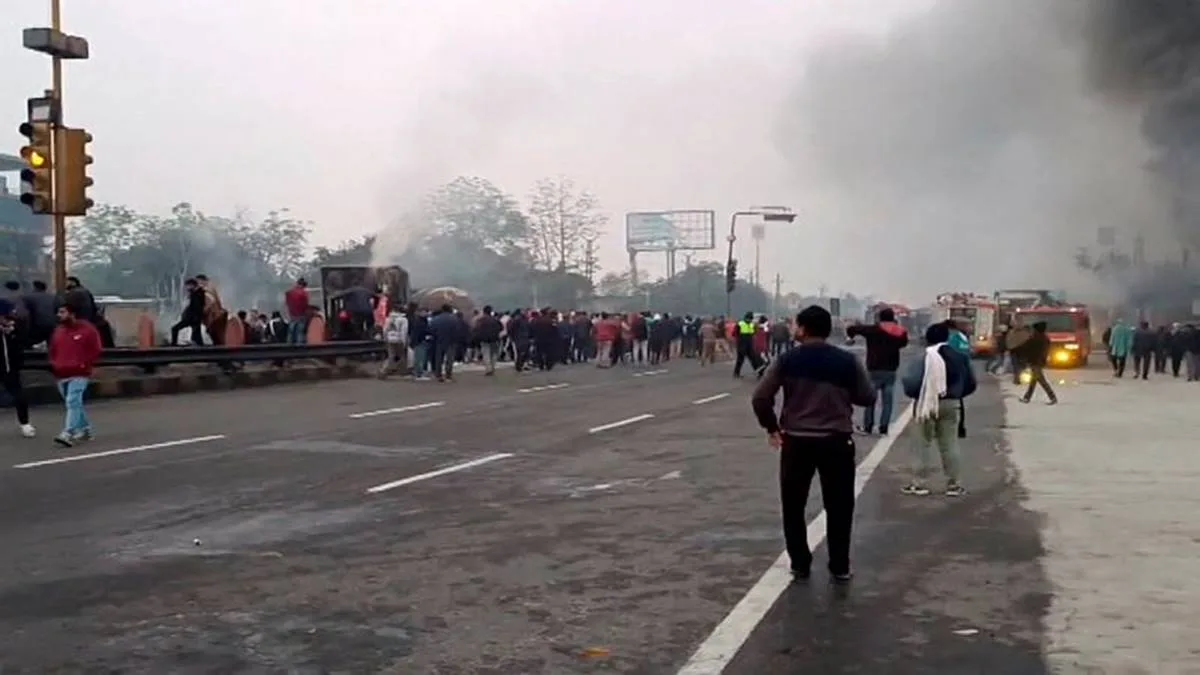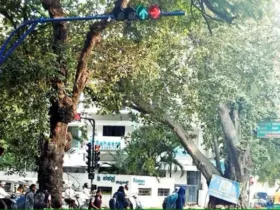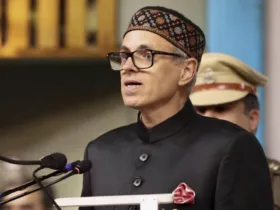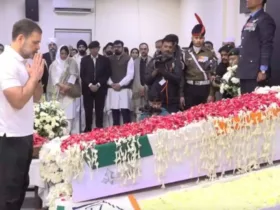In a devastating incident early this morning, a chemical-laden truck collided with multiple vehicles on the Jaipur-Ajmer highway near Bhankrota, leading to a massive fire that claimed at least five lives and left 36 others critically injured. The collision occurred around 6:30 AM near a petrol pump and Delhi Public School, causing widespread destruction and bringing traffic to a standstill on the busy highway.
Sequence of Events
The accident began when a truck transporting hazardous chemicals lost control and veered into the opposite lane. It collided with several vehicles, including another truck and a fuel tanker. The collision’s impact caused an explosion, igniting a fire that quickly spread to nearby vehicles and structures.
Eyewitnesses described scenes of chaos as flames engulfed a section of the highway, trapping commuters in their vehicles. The fire extended to a nearby pipe factory and a petrol pump, exacerbating the situation. A sleeper bus and around 20 CNG cars parked in the vicinity were also caught in the blaze, adding to the intensity of the inferno.
Casualties and Injuries
At least five individuals were burned alive at the site, with the bodies charred beyond recognition. Among the injured, 36 people suffered severe burns, with many sustaining over 50% burns. The victims were rushed to Sawai Man Singh (SMS) Hospital in Jaipur, where emergency medical teams worked tirelessly to stabilize them. The hospital authorities have confirmed that several patients are in critical condition, and the death toll may rise.
#WATCH | The moment when the truck collision led to a massive fire outside a petrol pump near #Jaipur pic.twitter.com/COUSG1SlCy
— The Indian Express (@IndianExpress) December 20, 2024
Damage and Disruption
The accident’s aftermath is staggering. The fire destroyed approximately 40 vehicles, including private cars, trucks, and buses. A 300-meter stretch of the highway was severely affected, leaving the area unrecognizable. The nearby petrol pump and pipe factory were completely gutted, causing significant financial losses.
Traffic on the Jaipur-Ajmer highway came to a halt as authorities cordoned off the area to facilitate rescue operations. Commuters were advised to take alternative routes, leading to congestion on secondary roads. The highway, a major arterial route, is expected to remain closed for several hours as cleanup efforts continue.
Emergency Response
As soon as reports of the incident surfaced, around 30 fire brigade teams were dispatched to the scene. Firefighters battled the blaze for hours before bringing it under control. Rescue teams worked alongside them to evacuate trapped individuals and recover bodies from the wreckage.
Ambulances ferried the injured to SMS Hospital, where additional medical staff was called in to handle the emergency. Blood donation drives were organized to ensure a steady supply for surgeries and treatments.
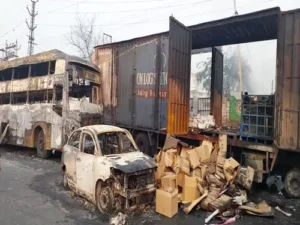
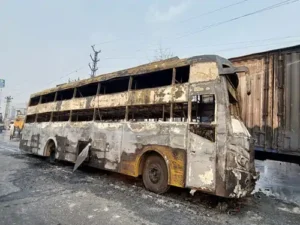
Government’s Reaction
Rajasthan Chief Minister Bhajanlal Sharma expressed profound grief over the tragedy. He visited SMS Hospital to meet the injured and review the treatment being provided. The Chief Minister directed officials to ensure the best possible care for the victims and announced an ex-gratia compensation for the families of the deceased and injured.
Health Minister Gajendra Singh Khimsar also visited the hospital and assured the public that all necessary measures were being taken to handle the situation. He commended the swift response of emergency services and emphasized the need for enhanced safety protocols, particularly for vehicles transporting hazardous materials.
Investigation
Preliminary investigations suggest that the chemical-laden truck’s driver lost control, possibly due to over-speeding or brake failure. The authorities are examining CCTV footage from the area to piece together the sequence of events. The truck’s cargo is being analyzed to determine the nature of the chemicals and their role in exacerbating the fire.
The police have registered a case against the truck driver, who is reportedly among the injured and is undergoing treatment under police custody. Investigators are also questioning the owners of the truck and the petrol pump to ascertain if any lapses in safety protocols contributed to the disaster.
Safety Concerns
This incident highlights the dangers of transporting hazardous materials on public roads. Experts have pointed out several gaps in safety standards, including inadequate training for drivers, poorly maintained vehicles, and the lack of proper monitoring mechanisms.
The fire also raises questions about the proximity of petrol pumps and industrial facilities to highways. Urban planners and safety regulators have long advocated for stricter zoning laws to prevent such disasters.
Public Reaction
The tragedy has sparked outrage and grief among the public. Social media platforms are flooded with messages of condolence for the victims and calls for stricter enforcement of traffic and safety regulations. Several NGOs have stepped forward to support the injured and their families, providing financial aid and other assistance.
Local residents have also criticized the slow response of authorities in addressing the root causes of such accidents. Many have called for improved road infrastructure and the establishment of dedicated corridors for the transportation of hazardous goods.
Lessons and Way Forward
This catastrophic incident serves as a grim reminder of the importance of stringent safety measures and emergency preparedness. Key takeaways include:
Enhanced Safety Protocols: Mandatory training for drivers handling hazardous materials, regular vehicle inspections, and real-time monitoring systems should be implemented.
Zoning Regulations: Petrol pumps, factories, and other high-risk establishments should be located away from major highways to minimize collateral damage in case of accidents.
Emergency Infrastructure: The deployment of specialized firefighting units and well-equipped trauma centers near highways can significantly reduce casualties in similar incidents.
Public Awareness: Awareness campaigns highlighting the risks associated with hazardous materials can foster a culture of safety among drivers and the public.
Conclusion
The massive fire on the Jaipur-Ajmer highway is a tragic event that has left a lasting impact on the lives of the victims and their families. While the immediate focus is on rescue and relief efforts, it is imperative for authorities to address the systemic issues that led to this disaster. By learning from this incident and implementing robust safety measures, similar tragedies can be prevented in the future.

